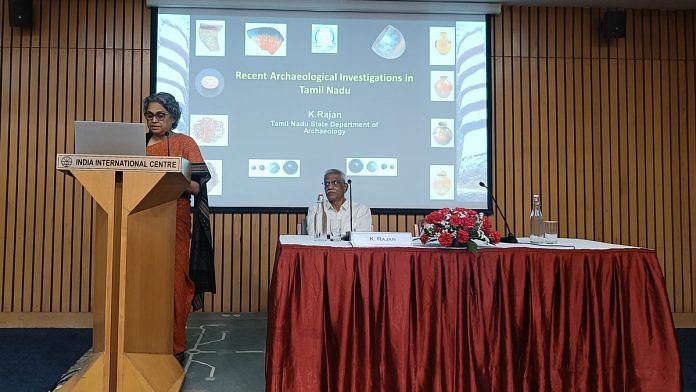New Delhi: The entire subcontinent was integrated by the third millennium BC, said Professor K Rajan, the archaeologist behind Tamil Nadu’s recent discovery on the Iron Age, dated to over 5,300 years ago. According to him, while the Indus Valley Civilisation was at its peak in North India, the Iron Age had already arrived in the south.
On 5 January, Tamil Nadu Chief Minister MK Stalin said that the copper and bronze age of the Indus Valley was contemporaneous with the Iron Age in southern India, particularly Tamil Nadu.
“In entire India, we are having chameleon beads, agate, lapis lazuli, high-tin bronze. All this indicates that the country was completely culturally integrated during that time,” said Rajan, academic and research advisor to the Tamil Nadu government and former professor in the Department of History, Pondicherry University.
He was speaking at Delhi’s India International Centre on 11 April, as part of a lecture titled ‘Recent Archaeological Investigations in Tamil Nadu’. The talk was organised by Ashoka University under its South Asia Beyond Borders series.
Rajan’s explorations have brought to light several important archaeological sites across Tamil Nadu, ranging from the prehistoric to early historic periods. He pointed out that from the prehistoric era onwards, there is tangible evidence of continuous human settlement in the region.
Some of the key sites explored under Rajan include Mayiladumparai in Krishnagiri district, Keezhadi in Sivaganga, and the burial site of Sivagalai in Thoothukudi. At the Sivagalai burial site, along with iron tools, the team collected a paddy sample from an urn, as well as charcoal samples. The charcoal was dated between 2953 BCE and 3345 BCE, suggesting that the introduction of iron in Tamil Nadu goes back to the first quarter of the 4th millennium BCE.
“Tamil Nadu is a very small geographical area and we have not achieved complete exploration. Now our government has agreed to have a comprehensive perspective plan for 25 years and is also ready to fund it,” said Rajan.
At the beginning of this year, Stalin released a 80-page report titled ‘Antiquity of Iron: Recent Radiometric Dates from Tamil Nadu’ where he declared that the Iron Age began on Tamil soil.
At the lecture, Rajan was introduced by historian Upinder Singh, professor at Ashoka University and organiser of the South Asia Beyond Borders series. She said the lecture aimed to present cutting-edge historical and archaeological research to a wide audience. Among those present in the audience of around 50 members were director general of the Archaeological Survey of India (ASI) YS Rawat and additional director general Alok Tripathi, along with other archaeologists, students, and heritage enthusiasts.
“Archaeological research in Tamil Nadu has created quite a buzz. It seems that it could force us to rethink long cherished ideas about the origins of writing, the origins of city life, and also the beginnings of technology,” said Singh, adding that Rajan has been at the forefront of several widely reported excavations and the research that has emerged from them.
Also Read: Tamil Nadu is waging a new North-South clash of civilisations— Sivagalai to Keezhadi
Tamil Nadu’s challenge to history
Before this recent discovery, the Iron Age in India was generally believed to date back to around 1000 BCE, following the decline of the Indus Valley Civilisation (3300 BCE–1300 BCE). The new timeline stemming from Tamil Nadu excavations suggests that the Iron Age was contemporaneous with the copper and bronze age in other parts of the subcontinent. It challenges the long-held assumption that iron arrived in India only after the Indus Valley period.
Rajan and his team tested samples from several archaeological sites across Tamil Nadu and recorded dates for iron objects ranging from 2175 BCE at Mayiladumparai to as early as 3345 BCE at Sivagalai.
At the Sivagalai burial site alone, around 85 iron objects were found, placed both inside and outside the urns.
According to Rajan, Tamil Nadu has 7,520 sites from the Palaeolithic, Microlithic, and Neolithic periods, but only 0.47 per cent of these have been excavated. The state, he added, also has around 60,000 recorded inscriptions compiled in 62 volumes.
“Now we are going for theme-based publication of the inscriptions,” he said, pointing out that they will publish details about all the state’s discovered sites based on their characteristics, such as “memorial inscriptions or theoretical inscriptions’.
He added that Tamil Nadu’s varied geographical zones each have distinct cultural characteristics.
“If you want to reconstruct the history of the micro-regions of Tamil Nadu, we have 1.5 lakh years of history. It is very difficult for a small team to reconstruct, but we are filling the gaps at the moment,” he said.
Also Read: Excavation is just the beginning. Complex sites like Kaushambi need evidence-based approach
Rewriting Brahmi script’s origins
Rajan’s excavations have helped resolve a 20-year debate over the dating of Tamil Brahmi. The traditional belief is that Brahmi gained prominence during Ashoka’s reign, but Rajan’s findings suggest it was already in use in Tamil Nadu before Ashoka. Historians have placed the origin of the Brahmi script in India around the 3rd century BCE.
At the site of Porunthal in the Amaravati river valley, Rajan’s team found a series of four liquid jars placed with paddy. While cleaning one of the jars, they discovered the name “Vaira” written in Brahmi.
“I thought that if I get the paddy, I may get the date for Brahmi,” said Rajan, adding that the samples were dated to 490 BCE and 450 BCE.
This is the first time a burial site with a Brahmi inscription has been scientifically dated.
“That means it was 200 years before King Ashoka,” Rajan said. “The writing system in India can be pushed back to the 5th century BC.”
(Edited by Asavari Singh)







Tamils live in an alternate universe – one where they are the supreme beings.